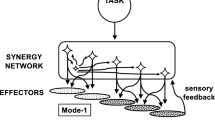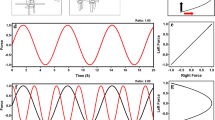Abstract
Previous work on the coordination between the upper and lower limbs has invariably shown that its accuracy/stability is primarily determined by the mutual direction between limbs in extrinsic space and not by muscle relationships. Here we show that muscle grouping does play a critical role in coordination of the arm and leg, in addition to direction. More specifically, the simultaneous activation of isofunctional muscles and/or limb movements proceeding in the same direction, results in more successful performance than the alternated activation of isofunctional muscles and/or movements occurring in different directions. In the absence of isofunctional muscle coupling, the mutual direction between the limbs plays a more prominent role in determining coordinative accuracy. These coordination constraints can largely account for the observed differences between ipsilateral and heterolateral limb coordination. The findings are discussed in view of the coalition of coordination constraints.




Similar content being viewed by others
References
Baldissera F, Borroni P, Cavallari P (2000) Neural compensation for mechanical differences between hand and foot during coupled oscillations of the two segments. Exp Brain Res 133:165–177
Baldissera F, Cavallari P (2001) Neural compensation for mechanical loading of the hand during coupled oscillations of the hand and foot. Exp Brain Res 139:18–29
Baldissera F, Cavallari P, Civaschi P (1982) Preferential coupling between voluntary movements of ipsilateral limbs. Neurosci Lett 34:95–100
Baldissera F, Cavallari P, Marini G, Tassone G (1991) Differential control of in-phase and anti-phase coupling of rhythmic movements of ipsilateral hand and foot. Exp Brain Res 83:375–380
Byblow WD, Summers JJ, Semjen A, Wuyts IJ, Carson RG (1999) Spontaneous and intentional pattern switching in a multisegmental bimanual coordination task. Motor Control 3:372–393
Caminiti R, Johnson PB, Galli C, Ferraina S, Burnod Y (1991) Making arm movements within different parts of space: the premotor and motor cortical representation of a coordinate system for reaching to visual targets. J Neurosci 11:1182–1197
Carson RG, Goodman D, Kelso JA, Elliott D (1995) Phase transitions and critical fluctuations in rhythmic coordination of ipsilateral hand and foot. J Mot Behav 27:211–224
Carson RG, Thomas J, Summers JJ, Walters MR, Semjen A (1997) The dynamics of bimanual circle drawing. Q J Exp Psychol A 50:664–683
Debaere F, Swinnen SP, Beatse E, Sunaert S, Van Hecke P, Duysens J (2001) Brain areas involved in interlimb coordination: a distributed network. Neuroimage 14:947–958
Georgopoulos AP (1995) Current issues in directional motor control. Trends Neurosci 18:506–510
Gould HJ III, Cusick CG, Pons TP, Kaas JH (1986) The relationship of corpus callosum connections to electrical stimulation maps of motor, supplementary motor, and the frontal eye fields in owl monkeys. J Comp Neurol 247:297–325
Haken H, Kelso JA, Bunz H (1985) A theoretical model of phase transitions in human hand movements. Biol Cybern 51:347–356
Ivry R, Diedrichsen J, Spencer R, Hazeltine E, Semjen A (2004) A cognitive neuroscience perspective on bimanual coordination and interference. In: Swinnen SP, Duysens J (eds) Neuro-behavioral determinants of interlimb coordination : a multidisciplinary approach. Kluwer, Dordrecht, pp 259–295
Jenny AB (1979) Commissural projections of the cortical hand motor area in monkeys. J Comp Neurol 188:137–145
Kakei S, Hoffman DS, Strick PL (1999) Muscle and movement representations in the primary motor cortex. Science 285:2136–2139
Kakei S, Hoffman DS, Strick PL (2003) Sensorimotor transformations in cortical motor areas. Neurosci Res 46:1–10
Kelso JA, Fink PW, DeLaplain CR, Carson RG (2001) Haptic information stabilizes and destabilizes coordination dynamics. Proc R Soc Lond B Biol Sci 268:1207–1213
Kelso JA, Jeka JJ (1992) Symmetry breaking dynamics of human multilimb coordination. J Exp Psychol Hum Percept Perform 18:645–668
Kinsbourne M, Hicks RE (1978) Mapping cerebral functional space : competition and collaboration in human performance. In: Kinsbourne M (ed) Assymmetrical function of the brain. Cambridge University Press, New York, pp 267–273
Mechsner F, Kerzel D, Knoblich G, Prinz W (2001) Perceptual basis of bimanual coordination. Nature 414:69–73
Oldfield RC (1971) The assessment and analysis of handedness: the Edinburgh inventory. Neuropsychologia 9:97–113
Pandya DN, Vignolo LA (1971) Intra-and interhemispheric projections of the precentral, premotor and arcuate areas in the rhesus monkey. Brain Res 26:217–233
Rouiller EM, Babalian A, Kazennikov O, Moret V, Yu XH, Wiesendanger M (1994) Transcallosal connections of the distal forelimb representations of the primary and supplementary motor cortical areas in macaque monkeys. Exp Brain Res 102:227–243
Scott SH, Kalaska JF (1995) Changes in motor cortex activity during reaching movements with similar hand paths but different arm postures. J Neurophysiol 73:2563–2567
Semjen A, Summers JJ, Cattaert D (1995) Hand coordination in bimanual circle drawing. J Exp Psychol-Hum Percept and Perform 21:1139–1157
Serrien DJ, Swinnen SP (1997) Isofrequency and multifrequency coordination patterns as a function of the planes of motion. Q J Exp Psychol Sect A-Hum Exp Psychol 50:386–404
Spijkers W, Heuer H (2004) Behavioral principles of interlimb coordination. In: Swinnen SP, Duysens J (eds) Neuro-behavioral determinants of interlimb coordination : a multidisciplinary approach. Kluwer, Dordrecht, pp 223–258
Swinnen SP (2002) Intermanual coordination: from behavioural principles to neural-network interactions. Nat Rev Neurosci 3:348–359
Swinnen SP, Dounskaia N, Duysens J (2002) Patterns of bimanual interference reveal movement encoding within a radial egocentric reference frame. J Cogn Neurosci 14:463–471
Swinnen SP, Dounskaia N, Verschueren S, Serrien DJ, Daelman A (1995) Relative phase destabilization during interlimb coordination: the disruptive role of kinesthetic afferences induced by passive movement. Exp Brain Res 105:439–454
Swinnen SP, Jardin K, Meulenbroek R, Dounskaia N, HofkensVanDenBrandt M (1997) Egocentric and allocentric constraints in the expression of patterns of interlimb coordination. J Cogn Neurosci 9:348–377
Swinnen SP, Jardin K, Verschueren S, Meulenbroek R, Franz L, Dounskaia N, Walter CB (1998) Exploring interlimb constraints during bimanual graphic performance: effects of muscle grouping and direction. Behav Brain Res 90:79–87
Temprado JJ, Swinnen SP, Carson RG, Tourment A, Laurent M (2003) Interaction of directional, neuromuscular and egocentric constraints on the stability of preferred bimanual coordination patterns. Hum Mov Sci 22:339–363
Temprado JJ, Zanone PG, Monne A, Laurent M (1999) Attentional load associated with performing and stabilizing preferred bimanual patterns. J Exp Psychol Hum Percept Perform 25:1579–1594
Wannier T, Bastiaanse C, Colombo G, Dietz V (2001) Arm to leg coordination in humans during walking, creeping and swimming activities. Exp Brain Res 141:375–379
Acknowledgments
Support for the present study was provided through a grant from the Research Council of K.U. Leuven (Contract No. OT/03/61) and the Research Programme of the Fund for Scientific Research—Flanders (G.0460.04).
Author information
Authors and Affiliations
Corresponding author
Rights and permissions
About this article
Cite this article
Meesen, R.L.J., Wenderoth, N., Temprado, J.J. et al. The coalition of constraints during coordination of the ipsilateral and heterolateral limbs. Exp Brain Res 174, 367–375 (2006). https://doi.org/10.1007/s00221-006-0471-1
Received:
Accepted:
Published:
Issue Date:
DOI: https://doi.org/10.1007/s00221-006-0471-1




